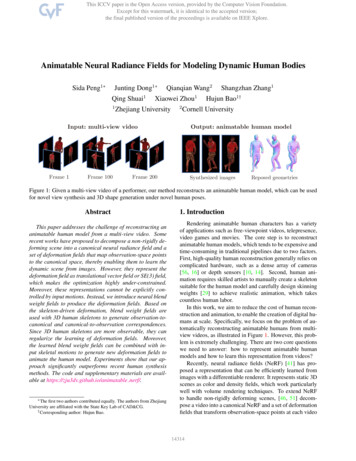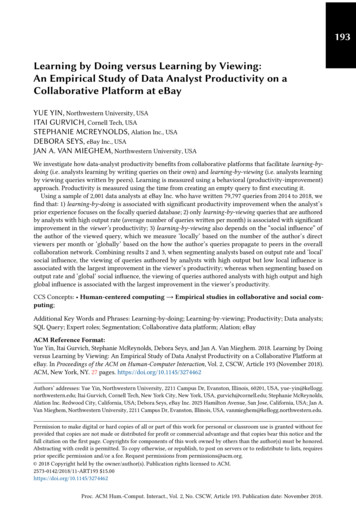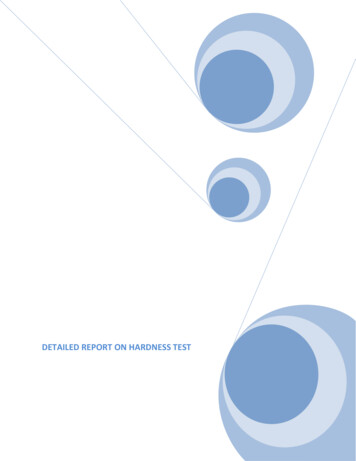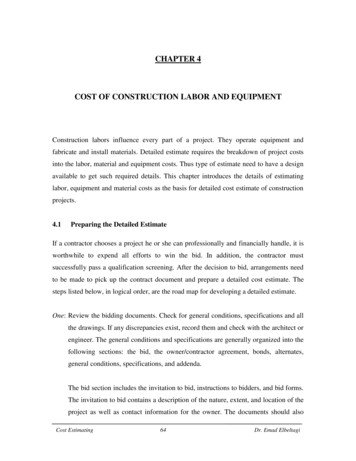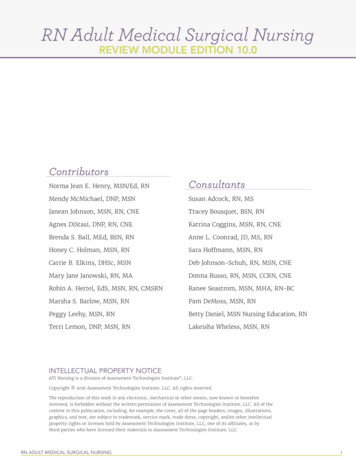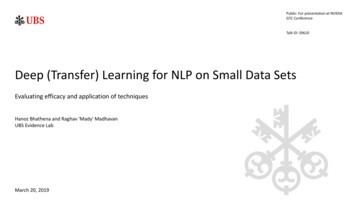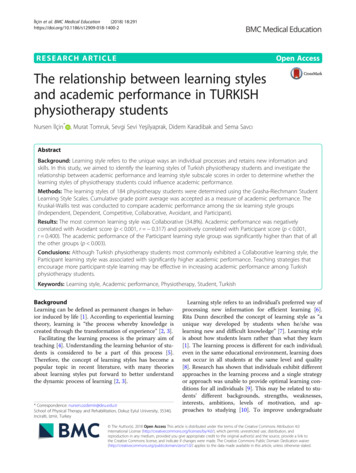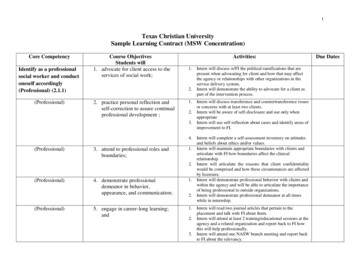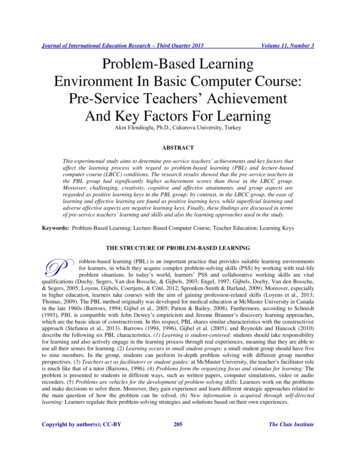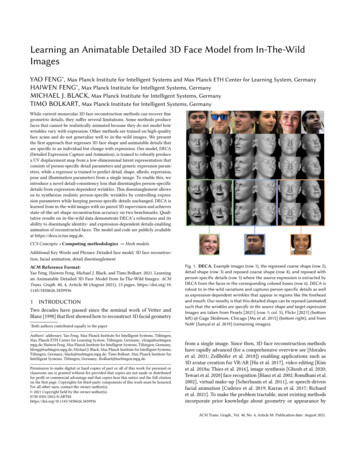
Transcription
Learning an Animatable Detailed 3D Face Model from In-The-WildImagesYAO FENG , Max Planck Institute for Intelligent Systems and Max Planck ETH Center for Learning System, GermanyHAIWEN FENG , Max Planck Institute for Intelligent Systems, GermanyMICHAEL J. BLACK, Max Planck Institute for Intelligent Systems, GermanyTIMO BOLKART, Max Planck Institute for Intelligent Systems, GermanyWhile current monocular 3D face reconstruction methods can recover finegeometric details, they suffer several limitations. Some methods producefaces that cannot be realistically animated because they do not model howwrinkles vary with expression. Other methods are trained on high-qualityface scans and do not generalize well to in-the-wild images. We presentthe first approach that regresses 3D face shape and animatable details thatare specific to an individual but change with expression. Our model, DECA(Detailed Expression Capture and Animation), is trained to robustly producea UV displacement map from a low-dimensional latent representation thatconsists of person-specific detail parameters and generic expression parameters, while a regressor is trained to predict detail, shape, albedo, expression,pose and illumination parameters from a single image. To enable this, weintroduce a novel detail-consistency loss that disentangles person-specificdetails from expression-dependent wrinkles. This disentanglement allowsus to synthesize realistic person-specific wrinkles by controlling expression parameters while keeping person-specific details unchanged. DECA islearned from in-the-wild images with no paired 3D supervision and achievesstate-of-the-art shape reconstruction accuracy on two benchmarks. Qualitative results on in-the-wild data demonstrate DECA’s robustness and itsability to disentangle identity- and expression-dependent details enablinganimation of reconstructed faces. The model and code are publicly availableat https://deca.is.tue.mpg.de.CCS Concepts: Computing methodologies Mesh models.Additional Key Words and Phrases: Detailed face model, 3D face reconstruction, facial animation, detail disentanglementACM Reference Format:Yao Feng, Haiwen Feng, Michael J. Black, and Timo Bolkart. 2021. Learningan Animatable Detailed 3D Face Model from In-The-Wild Images. ACMTrans. Graph. 40, 4, Article 88 (August 2021), 13 pages. ONTwo decades have passed since the seminal work of Vetter andBlanz [1998] that first showed how to reconstruct 3D facial geometry Bothauthors contributed equally to the paperAuthors’ addresses: Yao Feng, Max Planck Institute for Intelligent Systems, Tübingen,Max Planck ETH Center for Learning System, Tübingen, Germany, yfeng@tuebingen.mpg.de; Haiwen Feng, Max Planck Institute for Intelligent Systems, Tübingen, Germany,hfeng@tuebingen.mpg.de; Michael J. Black, Max Planck Institute for Intelligent Systems,Tübingen, Germany, black@tuebingen.mpg.de; Timo Bolkart, Max Planck Institute forIntelligent Systems, Tübingen, Germany, tbolkart@tuebingen.mpg.de.Permission to make digital or hard copies of part or all of this work for personal orclassroom use is granted without fee provided that copies are not made or distributedfor profit or commercial advantage and that copies bear this notice and the full citationon the first page. Copyrights for third-party components of this work must be honored.For all other uses, contact the owner/author(s). 2021 Copyright held by the org/10.1145/3450626.3459936Fig. 1. DECA. Example images (row 1), the regressed coarse shape (row 2),detail shape (row 3) and reposed coarse shape (row 4), and reposed withperson-specific details (row 5) where the source expression is extracted byDECA from the faces in the corresponding colored boxes (row 6). DECA isrobust to in-the-wild variations and captures person-specific details as wellas expression-dependent wrinkles that appear in regions like the foreheadand mouth. Our novelty is that this detailed shape can be reposed (animated)such that the wrinkles are specific to the source shape and target expression.Images are taken from Pexels [2021] (row 1; col. 5), Flickr [2021] (bottomleft) @ Gage Skidmore, Chicago [Ma et al. 2015] (bottom right), and fromNoW [Sanyal et al. 2019] (remaining images).from a single image. Since then, 3D face reconstruction methodshave rapidly advanced (for a comprehensive overview see [Moraleset al. 2021; Zollhöfer et al. 2018]) enabling applications such as3D avatar creation for VR/AR [Hu et al. 2017], video editing [Kimet al. 2018a; Thies et al. 2016], image synthesis [Ghosh et al. 2020;Tewari et al. 2020] face recognition [Blanz et al. 2002; Romdhani et al.2002], virtual make-up [Scherbaum et al. 2011], or speech-drivenfacial animation [Cudeiro et al. 2019; Karras et al. 2017; Richardet al. 2021]. To make the problem tractable, most existing methodsincorporate prior knowledge about geometry or appearance byACM Trans. Graph., Vol. 40, No. 4, Article 88. Publication date: August 2021.
88:2 Yao Feng, Haiwen Feng, Michael J. Black, Timo Bolkartleveraging pre-computed 3D face models [Brunton et al. 2014; Eggeret al. 2020]. These models reconstruct the coarse face shape but areunable to capture geometric details such as expression-dependentwrinkles, which are essential for realism and support analysis ofhuman emotion.Several methods recover detailed facial geometry [Abrevaya et al.2020; Cao et al. 2015; Chen et al. 2019; Guo et al. 2018; Richardsonet al. 2017; Tran et al. 2018, 2019], however, they require high-qualitytraining scans [Cao et al. 2015; Chen et al. 2019] or lack robustnessto occlusions [Abrevaya et al. 2020; Guo et al. 2018; Richardson et al.2017]. None of these explore how the recovered wrinkles changewith varying expressions. Previous methods that learn expressiondependent detail models [Bickel et al. 2008; Chaudhuri et al. 2020;Yang et al. 2020] either use detailed 3D scans as training data and,hence, do not generalize to unconstrained images [Yang et al. 2020],or model expression-dependent details as part of the appearancemap rather than the geometry [Chaudhuri et al. 2020], preventingrealistic mesh relighting.We introduce DECA (Detailed Expression Capture and Animation), which learns an animatable displacement model from in-thewild images without 2D-to-3D supervision. In contrast to prior work,these animatable expression-dependent wrinkles are specific to an individual and are regressed from a single image. Specifically, DECAjointly learns 1) a geometric detail model that generates a UV displacement map from a low-dimensional representation that consistsof subject-specific detail parameters and expression parameters, and2) a regressor that predicts subject-specific detail, albedo, shape,expression, pose, and lighting parameters from an image. The detailmodel builds upon FLAME’s [Li et al. 2017] coarse geometry, and weformulate the displacements as a function of subject-specific detailparameters and FLAME’s jaw pose and expression parameters.This enables important applications such as easy avatar creationfrom a single image. While previous methods can capture detailedgeometry in the image, most applications require a face that can beanimated. For this, it is not sufficient or recover accurate geometryin the input image. Rather, we must be able to animate that detailed geometry and, more specifically, the details should be personspecific.To gain control over expression-dependent wrinkles of the reconstructed face, while preserving person-specific details (i.e. moles,pores, eyebrows, and expression-independent wrinkles), the personspecific details and expression-dependent wrinkles must be disentangled. Our key contribution is a novel detail consistency loss thatenforces this disentanglement. During training, if we are given twoimages of the same person with different expressions, we observethat their 3D face shape and their person-specific details are thesame in both images, but the expression and the intensity of thewrinkles differ with expression. We exploit this observation duringtraining by swapping the detail codes between different images ofthe same identity and enforcing the newly rendered results to looksimilar to the original input images. Once trained, DECA reconstructs a detailed 3D face from a single image (Fig. 1, third row) inreal time (about 120fps on a Nvidia Quadro RTX 5000), and is ableto animate the reconstruction with realistic adaptive expressionwrinkles (Fig. 1, fifth row).ACM Trans. Graph., Vol. 40, No. 4, Article 88. Publication date: August 2021.In summary, our main contributions are: 1) The first approachto learn an animatable displacement model from in-the-wild imagesthat can synthesize plausible geometric details by varying expression parameters. 2) A novel detail consistency loss that disentanglesidentity-dependent and expression-dependent facial details. 3) Reconstruction of geometric details that is, unlike most competingmethods, robust to common occlusions, wide pose variation, and illumination variation. This is enabled by our low-dimensional detailrepresentation, the detail disentanglement, and training from a largedataset of in-the-wild images. 4) State-of-the-art shape reconstruction accuracy on two different benchmarks. 5) The code and modelare available for research purposes at https://deca.is.tue.mpg.de.2RELATED WORKThe reconstruction of 3D faces from visual input has received significant attention over the last decades after the pioneering work ofParke [1974], the first method to reconstruct 3D faces from multiview images. While a large body of related work aims to reconstruct 3D faces from various input modalities such as multi-viewimages [Beeler et al. 2010; Cao et al. 2018a; Pighin et al. 1998], videodata [Garrido et al. 2016; Ichim et al. 2015; Jeni et al. 2015; Shiet al. 2014; Suwajanakorn et al. 2014], RGB-D data [Li et al. 2013;Thies et al. 2015; Weise et al. 2011] or subject-specific image collections [Kemelmacher-Shlizerman and Seitz 2011; Roth et al. 2016],our main focus is on methods that use only a single RGB image. Fora more comprehensive overview, see Zollhöfer et al. [2018].Coarse reconstruction: Many monocular 3D face reconstructionmethods follow Vetter and Blanz [1998] by estimating coefficients ofpre-computed statistical models in an analysis-by-synthesis fashion.Such methods can be categorized into optimization-based [Aldrianand Smith 2013; Bas et al. 2017; Blanz et al. 2002; Blanz and Vetter1999; Gerig et al. 2018; Romdhani and Vetter 2005; Thies et al. 2016],or learning-based methods [Chang et al. 2018; Deng et al. 2019;Genova et al. 2018; Kim et al. 2018b; Ploumpis et al. 2020; Richardsonet al. 2016; Sanyal et al. 2019; Tewari et al. 2017; Tran et al. 2017;Tu et al. 2019]. These methods estimate parameters of a statisticalface model with a fixed linear shape space, which captures onlylow-frequency shape information. This results in overly-smoothreconstructions.Several works are model-free and directly regress 3D faces (i.e.voxels [Jackson et al. 2017] or meshes [Dou et al. 2017; Feng et al.2018b; Güler et al. 2017; Wei et al. 2019]) and hence can capturemore variation than the model-based methods. However, all thesemethods require explicit 3D supervision, which is provided eitherby an optimization-based model fitting [Feng et al. 2018b; Güleret al. 2017; Jackson et al. 2017; Wei et al. 2019] or by synthetic datagenerated by sampling a statistical face model [Dou et al. 2017] andtherefore also only capture coarse shape variations.Instead of capturing high-frequency geometric details, some methods reconstruct coarse facial geometry along with high-fidelitytextures [Gecer et al. 2019; Saito et al. 2017; Slossberg et al. 2018;Yamaguchi et al. 2018]. As this “bakes" shading details into the texture, lighting changes do not affect these details, limiting realismand the range of applications. To enable animation and relighting,DECA captures these details as part of the geometry.
Learning an Animatable Detailed 3D Face Model from In-The-Wild ImagesDetail reconstruction: Another body of work aims to reconstructfaces with “mid-frequency" details. Common optimization-basedmethods fit a statistical face model to images to obtain a coarseshape estimate, followed by a shape from shading (SfS) method toreconstruct facial details from monocular images [Jiang et al. 2018;Li et al. 2018; Riviere et al. 2020], or videos [Garrido et al. 2016;Suwajanakorn et al. 2014]. Unlike DECA, these approaches are slow,the results lack robustness to occlusions, and the coarse model fittingstep requires facial landmarks, making them error-prone for largeviewing angles and occlusions.Most regression-based approaches [Cao et al. 2015; Chen et al.2019; Guo et al. 2018; Lattas et al. 2020; Richardson et al. 2017; Tranet al. 2018] follow a similar approach by first reconstructing the parameters of a statistical face model to obtain a coarse shape, followedby a refinement step to capture localized details. Chen et al. [2019]and Cao et al. [2015] compute local wrinkle statistics from highresolution scans and leverage these to constrain the fine-scale detailreconstruction from images [Chen et al. 2019] or videos [Cao et al.2015]. Guo et al. [2018] and Richardson et al. [2017] directly regressper-pixel displacement maps. All these methods only reconstructfine-scale details in non-occluded regions, causing visible artifacts inthe presence of occlusions. Tran et al. [2018] gain robustness to occlusions by applying a face segmentation method [Nirkin et al. 2018]to determine occluded regions, and employ an example-based holefilling approach to deal with the occluded regions. Further, modelfree methods exist that directly reconstruct detailed meshes [Selaet al. 2017; Zeng et al. 2019] or surface normals that add detail tocoarse reconstructions [Abrevaya et al. 2020; Sengupta et al. 2018].Tran et al. [2019] and Tewari et al. [2019; 2018] jointly learn a statistical face model and reconstruct 3D faces from images. While offeringmore flexibility than fixed statistical models, these methods capturelimited geometric details compared to other detail reconstructionmethods. Lattas et al. [2020] use image translation networks to inferthe diffuse normals and specular normals, resulting in realistic rendering. Unlike DECA, none of these detail reconstruction methodsoffer animatable details after reconstruction.Animatable detail reconstruction: Most relevant to DECA aremethods that reconstruct detailed faces while allowing animationof the result. Existing methods [Bickel et al. 2008; Golovinskiy et al.2006; Ma et al. 2008; Shin et al. 2014; Yang et al. 2020] learn correlations between wrinkles or attributes like age and gender [Golovinskiy et al. 2006], pose [Bickel et al. 2008] or expression [Shin et al.2014; Yang et al. 2020] from high-quality 3D face meshes [Bickelet al. 2008]. Fyffe et al. [2014] use optical flow correspondence computed from dynamic video frames to animate static high-resolutionscans. In contrast, DECA learns an animatable detail model solelyfrom in-the-wild images without paired 3D training data. WhileFaceScape [Yang et al. 2020] predicts an animatable 3D face from asingle image, the method is not robust to occlusions. This is due toa two step reconstruction process: first optimize the coarse shape,then predict a displacement map from the texture map extractedwith the coarse reconstruction.Chaudhuri et al. [2020] learn identity and expression correctiveblendshapes with dynamic (expression-dependent) albedo maps[Nagano et al. 2018]. They model geometric details as part of thealbedo map, and therefore, the shading of these details does not 88:3adapt with varying lighting. This results in unrealistic renderings. Incontrast, DECA models details as geometric displacements, whichlook natural when re-lit.In summary, DECA occupies a unique space. It takes a singleimage as input and produces person-specific details that can be realistically animated. While some methods produce higher-frequencypixel-aligned details, these are not animatable. Still other methodsrequire high-resolution scans for training. We show that these arenot necessary and that animatable details can be learned from 2Dimages without paired 3D ground truth. This is not just convenient, but means that DECA learns to be robust to a wide variety ofreal-world variation. We want to emphasize that, while elements ofDECA are built on well-understood principles (dating back to Vetterand Blanz), our core contribution is new and essential. The key tomaking DECA work is the detail consistency loss, which has notappeared previously in the literature.3PRELIMINARIESGeometry prior: FLAME [Li et al. 2017] is a statistical 3D headmodel that combines separate linear identity shape and expressionspaces with linear blend skinning (LBS) and pose-dependent corrective blendshapes to articulate the neck, jaw, and eyeballs. Givenparameters of facial identity 𝜷 R 𝜷 , pose 𝜽 R3𝑘 3 (with 𝑘 4joints for neck, jaw, and eyeballs), and expression 𝝍 R 𝝍 , FLAMEoutputs a mesh with 𝑛 5023 vertices. The model is defined as𝑀 (𝜷, 𝜽, 𝝍) 𝑊 (𝑇𝑃 (𝜷, 𝜽, 𝝍), J(𝜷), 𝜽, W),(1)with the blend skinning function 𝑊 (T, J, 𝜽, W) that rotates thevertices in T R3𝑛 around joints J R3𝑘 , linearly smoothed byblendweights W R𝑘 𝑛 . The joint locations J are defined as afunction of the identity 𝜷. Further,𝑇𝑃 (𝜷, 𝜽, 𝝍) T 𝐵𝑆 (𝜷; S) 𝐵𝑃 (𝜽 ; P) 𝐵𝐸 (𝝍; E)(2)denotes the mean template T in “zero pose” with added shapeblendshapes 𝐵𝑆 (𝜷; S) : R 𝜷 R3𝑛 , pose correctives 𝐵𝑃 (𝜽 ; P) :R3𝑘 3 R3𝑛 , and expression blendshapes 𝐵𝐸 (𝝍; E) : R 𝝍 R3𝑛 ,with the learned identity, pose, and expression bases (i.e. linearsubspaces) S, P and E. See [Li et al. 2017] for details.Appearance model: FLAME does not have an appearance model,hence we convert the Basel Face Model’s linear albedo subspace[Paysan et al. 2009] into the FLAME UV layout to make it compatiblewith FLAME. The appearance model outputs a UV albedo map𝐴(𝜶 ) R𝑑 𝑑 3 for albedo parameters 𝜶 R 𝜶 .Camera model: Photographs in existing in-the-wild face datasetsare often taken from a distance. We, therefore, use an orthographiccamera model c to project the 3D mesh into image space. Facevertices are projected into the image as v 𝑠Π(𝑀𝑖 ) t, where𝑀𝑖 R3 is a vertex in 𝑀, Π R2 3 is the orthographic 3D-2Dprojection matrix, and 𝑠 R and t R2 denote isotropic scale and2D translation, respectively. The parameters 𝑠, and t are summarizedas 𝒄.Illumination model: For face reconstruction, the most frequentlyemployed illumination model is based on Spherical Harmonics(SH) [Ramamoorthi and Hanrahan 2001]. By assuming that the lightsource is distant and the face’s surface reflectance is Lambertian,ACM Trans. Graph., Vol. 40, No. 4, Article 88. Publication date: August 2021.
88:4 Yao Feng, Haiwen Feng, Michael J. Black, Timo Bolkartthe shaded face image is computed as:𝐵(𝜶 , l, 𝑁𝑢𝑣 )𝑖,𝑗 𝐴(𝜶 )𝑖,𝑗 9Õl𝑘 𝐻𝑘 (𝑁𝑖,𝑗 ),(3)𝑘 1where the albedo, 𝐴, surface normals, 𝑁 , and shaded texture, 𝐵,are represented in UV coordinates and where 𝐵𝑖,𝑗 R3 , 𝐴𝑖,𝑗 R3 ,and 𝑁𝑖,𝑗 R3 denote pixel (𝑖, 𝑗) in the UV coordinate system. TheSH basis and coefficients are defined as 𝐻𝑘 : R3 R and l [l𝑇1 , · · · , l𝑇9 ]𝑇 , with l𝑘 R3 , and denotes the Hadamard product.Texture rendering: Given the geometry parameters (𝜷, 𝜽, 𝝍), albedo(𝜶 ), lighting (l) and camera information 𝒄, we can generate the 2Dimage 𝐼𝑟 by rendering as 𝐼𝑟 R (𝑀, 𝐵, c), where R denotes therendering function.FLAME is able to generate the face geometry with various poses,shapes and expressions from a low-dimensional latent space. However, the representational power of the model is limited by the lowmesh resolution and therefore mid-frequency details are mostlymissing from FLAME’s surface. The next section introduces ourexpression-dependent displacement model that augments FLAMEwith mid-frequency details, and it demonstrates how to reconstructthis geometry from a single image and animate it.4METHODDECA learns to regress a parameterized face model with geometric detail solely from in-the-wild training images (Fig. 2 left). Oncetrained, DECA reconstructs the 3D head with detailed face geometryfrom a single face image, 𝐼 . The learned parametrization of the reconstructed details enables us to then animate the detail reconstructionby controlling FLAME’s expression and jaw pose parameters (Fig. 2,right). This synthesizes new wrinkles while keeping person-specificdetails unchanged.Key idea: The key idea of DECA is grounded in the observationthat an individual’s face shows different details (i.e. wrinkles), depending on their facial expressions but that other properties of theirshape remain unchanged. Consequently, facial details should beseparated into static person-specific details and dynamic expressiondependent details such as wrinkles [Li et al. 2009]. However, disentangling static and dynamic facial details is a non-trivial task.Static facial details are different across people, whereas dynamicexpression dependent facial details even vary for the same person.Thus, DECA learns an expression-conditioned detail model to inferfacial details from both the person-specific detail latent space andthe expression space.The main difficulty in learning a detail displacement model is thelack of training data. Prior work uses specialized camera systemsto scan people in a controlled environment to obtain detailed facialgeometry. However, this approach is expensive and impractical forcapturing large numbers of identities with varying expressions anddiversity in ethnicity and age. Therefore we propose an approachto learn detail geometry from in-the-wild images.4.1Coarse reconstructionWe first learn a coarse reconstruction (i.e. in FLAME’s model space)in an analysis-by-synthesis way: given a 2D image 𝐼 as input, weencode the image into a latent code, decode this to synthesize aACM Trans. Graph., Vol. 40, No. 4, Article 88. Publication date: August 2021.2D image 𝐼𝑟 , and minimize the difference between the synthesizedimage and the input. As shown in Fig. 2, we train an encoder 𝐸𝑐 ,which consists of a ResNet50 [He et al. 2016] network followed by afully connected layer, to regress a low-dimensional latent code. Thislatent code consists of FLAME parameters 𝜷, 𝝍, 𝜽 (i.e. representingthe coarse geometry), albedo coefficients 𝜶 , camera 𝒄, and lightingparameters l. More specifically, the coarse geometry uses the first100 FLAME shape parameters (𝜷), 50 expression parameters (𝝍), and50 albedo parameters (𝜶 ). In total, 𝐸𝑐 predicts a 236 dimensionallatent code.Given a dataset of 2𝐷 face images 𝐼𝑖 with multiple images persubject, corresponding identity labels 𝑐𝑖 , and 68 2𝐷 keypoints k𝑖 perimage, the coarse reconstruction branch is trained by minimizing𝐿coarse 𝐿lmk 𝐿eye 𝐿pho 𝐿𝑖𝑑 𝐿𝑠𝑐 𝐿reg ,(4)with landmark loss 𝐿lmk , eye closure loss 𝐿eye , photometric loss 𝐿pho ,identity loss 𝐿𝑖𝑑 , shape consistency loss 𝐿𝑠𝑐 and regularization 𝐿reg .Landmark re-projection loss: The landmark loss measures thedifference between ground-truth 2𝐷 face landmarks k𝑖 and thecorresponding landmarks on the FLAME model’s surface 𝑀𝑖 R3 , projected into the image by the estimated camera model. Thelandmark loss is defined as68Õ k𝑖 𝑠Π(𝑀𝑖 ) t 1 .𝐿lmk (5)𝑖 1Eye closure loss: The eye closure loss computes the relative offsetof landmarks k𝑖 and k 𝑗 on the upper and lower eyelid, and measures the difference to the offset of the corresponding landmarkson FLAME’s surface 𝑀𝑖 and 𝑀 𝑗 projected into the image. Formally,the loss is given asÕ𝐿eye k𝑖 k 𝑗 𝑠Π(𝑀𝑖 𝑀 𝑗 ) 1 ,(6)(𝑖,𝑗) 𝐸where 𝐸 is the set of upper/lower eyelid landmark pairs. While thelandmark loss, 𝐿lmk (Eq. 5), penalizes the absolute landmark locationdifferences, 𝐿eye penalizes the relative difference between eyelidlandmarks. Because the eye closure loss 𝐿eye is translation invariant,it is less susceptible to a misalignment between the projected 3Dface and the image, compared to 𝐿lmk . In contrast, simply increasingthe landmark loss for the eye landmarks affects the overall faceshape and can lead to unsatisfactory reconstructions. See Fig. 10 forthe effect of the eye-closure loss.Photometric loss: The photometric loss computes the error between the input image 𝐼 and the rendering 𝐼𝑟 as𝐿pho 𝑉𝐼 (𝐼 𝐼𝑟 ) 1,1 .Here, 𝑉𝐼 is a face mask with value 1 in the face skin region, and value0 elsewhere obtained by an existing face segmentation method [Nirkinet al. 2018], and denotes the Hadamard product. Computing theerror in only the face region provides robustness to common occlusions by e.g. hair, clothes, sunglasses, etc. Without this, the predictedalbedo will also consider the color of the occluder, which may befar from skin color, resulting in unnatural rendering (see Fig. 10).Identity loss: Recent 3D face reconstruction methods demonstratethe effectiveness of utilizing an identity loss to produce more realistic face shapes [Deng et al. 2019; Gecer et al. 2019]. Motivated by
Learning an Animatable Detailed 3D Face Model from In-The-Wild Images 88:5Fig. 2. DECA training and animation. During training (left box), DECA estimates parameters to reconstruct face shape for each image with the aid of theshape consistency information (following the blue arrows) and, then, learns an expression-conditioned displacement model by leveraging detail consistencyinformation (following the red arrows) from multiple images of the same individual (see Sec. 4.3 for details). While the analysis-by-synthesis pipeline is, bynow, standard, the yellow box region contains our key novelty. This displacement consistency loss is further illustrated in Fig. 3. Once trained, DECA animatesa face (right box) by combining the reconstructed source identity’s shape, head pose, and detail code, with the reconstructed source expression’s jaw pose andexpression parameters to obtain an animated coarse shape and an animated displacement map. Finally, DECA outputs an animated detail shape. Images aretaken from NoW [Sanyal et al. 2019]. Note that NoW images are not used for training DECA, but are just selected for illustration purposes.Fig. 3. Detail consistency loss. DECA uses multiple images of the sameperson during training to disentangle static person-specific details fromexpression-dependent details. When properly factored, we should be able totake the detail code from one image of a person and use it to reconstruct another image of that person with a different expression. See Sec. 4.3 for details.Images are taken from NoW [Sanyal et al. 2019]. Note that NoW imagesare not used for training, but are just selected for illustration purposes.this, we also use a pretrained face recognition network [Cao et al.2018b], to employ an identity loss during training.The face recognition network 𝑓 outputs feature embeddings ofthe rendered images and the input image, and the identity lossthen measures the cosine similarity between the two embeddings.Formally, the loss is defined as𝐿𝑖𝑑 1 𝑓 (𝐼 ) 𝑓 (𝐼𝑟 ). 𝑓 (𝐼 ) 2 · 𝑓 (𝐼𝑟 ) 2(7)By computing the error between embeddings, the loss encouragesthe rendered image to capture fundamental properties of a person’sidentity, ensuring that the rendered image looks like the same personas the input subject. Figure 10 shows that the coarse shape resultswith 𝐿𝑖𝑑 look more like the input subject than those without.Shape consistency loss: Given two images 𝐼𝑖 and 𝐼 𝑗 of the samesubject (i.e. 𝑐𝑖 𝑐 𝑗 ), the coarse encoder 𝐸𝑐 should output the sameshape parameters (i.e. 𝜷 𝑖 𝜷 𝑗 ). Previous work encourages shapeconsistency by enforcing the distance between 𝜷 𝑖 and 𝜷 𝑗 to besmaller by a margin than the distance to the shape coefficientscorresponding to a different subject [Sanyal et al. 2019]. However,choosing this fixed margin is challenging in practice. Instead, wepropose a different strategy by replacing 𝜷 𝑖 with 𝜷 𝑗 while keepingall other parameters unchanged. Given that 𝜷 𝑖 and 𝜷 𝑗 represent thesame subject, this new set of parameters must reconstruct 𝐼𝑖 well.Formally, we minimize𝐿𝑠𝑐 𝐿coarse (𝐼𝑖 , R (𝑀 (𝜷 𝑗 , 𝜽 𝑖 , 𝝍 𝑖 ), 𝐵(𝜶 𝑖 , l𝑖 , 𝑁𝑢𝑣,𝑖 ), c𝑖 )).(8)The goal is to make the rendered images look like the real person.If the method has correctly estimated the shape of the face in twoimages of the same person, then swapping the shape parametersbetween these images should produce rendered images that areindistinguishable. Thus, we employ the photometric and identityloss on the rendered images from swapped shape parameters.Regularization: 𝐿reg regularizes shape 𝐸 𝜷 𝜷 22 , expression𝐸 𝝍 𝝍 22 , and albedo 𝐸 𝜶 𝜶 22 .4.2Detail reconstructionThe detail reconstruction augments the coarse FLAME geometrywith a detailed UV displacement map 𝐷 [ 0.01, 0.01]𝑑 𝑑 (seeFig. 2). Similar to the coarse reconstruction, we train an encoder 𝐸𝑑ACM Trans. Graph., Vol. 40, No. 4, Article 88. Publication date: August 2021.
88:6 Yao Feng, Haiwen Feng, Michael J. Black, Timo Bolkart(with the same architecture as 𝐸𝑐 ) to encode 𝐼 to a 128-dimensionallatent code 𝜹, representing subject-specific details. The latent code𝜹 is then concatenated with FLAME’s expression 𝝍 and jaw poseparameters 𝜽 𝑗𝑎𝑤 , and decoded by 𝐹𝑑 to 𝐷.Detail decoder: The detail decoder is defined as𝐷 𝐹𝑑 (𝜹, 𝝍, 𝜽 𝑗𝑎𝑤 ),(9)where 𝐿𝑀 (𝑙𝑎𝑦𝑒𝑟𝑡ℎ ) denotes the ID-MRF loss that is employed onthe feature patches extracted from 𝐼𝑟′ and 𝐼 with layer 𝑙𝑎𝑦𝑒𝑟𝑡ℎ ofVGG19. As with the photometric losses, we compute 𝐿mrf only forthe face skin region in UV space.Soft symmetry loss: To add robustness to self-occlusions, we adda soft symmetry loss to regularize non-visible face parts. Specifically,we minimizeR128where the detail code 𝜹 controls the static person-specificdetails. We leverage the expression 𝝍 R50 and jaw pose parameters𝜽 𝑗𝑎𝑤 R3 from the coarse reconstruction branch to capture thedynamic expression wri
Parke [1974], the first method to reconstruct 3D faces from multi-view images. While a large body of related work aims to recon-struct 3D faces from various input modalities such as multi-view images [Beeler et al. 2010; Cao et al. 2018a; Pighin et al. 1998], video data [Garrido et al.
